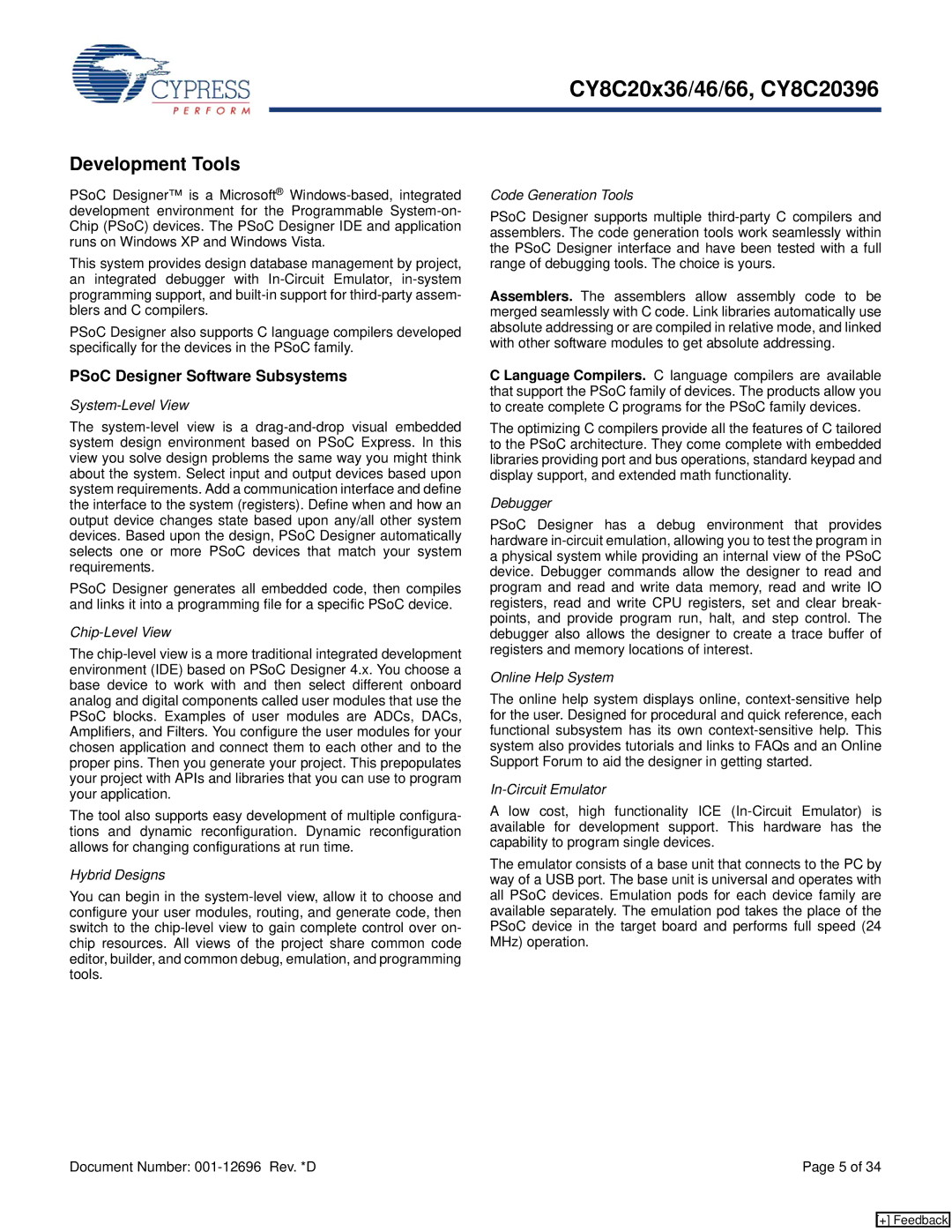Development Tools
PSoC Designer™ is a Microsoft® Windows-based, integrated development environment for the Programmable System-on- Chip (PSoC) devices. The PSoC Designer IDE and application runs on Windows XP and Windows Vista.
This system provides design database management by project, an integrated debugger with In-Circuit Emulator, in-system programming support, and built-in support for third-party assem- blers and C compilers.
PSoC Designer also supports C language compilers developed specifically for the devices in the PSoC family.
PSoC Designer Software Subsystems
System-Level View
The system-level view is a drag-and-drop visual embedded system design environment based on PSoC Express. In this view you solve design problems the same way you might think about the system. Select input and output devices based upon system requirements. Add a communication interface and define the interface to the system (registers). Define when and how an output device changes state based upon any/all other system devices. Based upon the design, PSoC Designer automatically selects one or more PSoC devices that match your system requirements.
PSoC Designer generates all embedded code, then compiles and links it into a programming file for a specific PSoC device.
Chip-Level View
The chip-level view is a more traditional integrated development environment (IDE) based on PSoC Designer 4.x. You choose a base device to work with and then select different onboard analog and digital components called user modules that use the PSoC blocks. Examples of user modules are ADCs, DACs, Amplifiers, and Filters. You configure the user modules for your chosen application and connect them to each other and to the proper pins. Then you generate your project. This prepopulates your project with APIs and libraries that you can use to program your application.
The tool also supports easy development of multiple configura- tions and dynamic reconfiguration. Dynamic reconfiguration allows for changing configurations at run time.
Hybrid Designs
You can begin in the system-level view, allow it to choose and configure your user modules, routing, and generate code, then switch to the chip-level view to gain complete control over on- chip resources. All views of the project share common code editor, builder, and common debug, emulation, and programming tools.
Code Generation Tools
PSoC Designer supports multiple third-party C compilers and assemblers. The code generation tools work seamlessly within the PSoC Designer interface and have been tested with a full range of debugging tools. The choice is yours.
Assemblers. The assemblers allow assembly code to be merged seamlessly with C code. Link libraries automatically use absolute addressing or are compiled in relative mode, and linked with other software modules to get absolute addressing.
C Language Compilers. C language compilers are available that support the PSoC family of devices. The products allow you to create complete C programs for the PSoC family devices.
The optimizing C compilers provide all the features of C tailored to the PSoC architecture. They come complete with embedded libraries providing port and bus operations, standard keypad and display support, and extended math functionality.
Debugger
PSoC Designer has a debug environment that provides hardware in-circuit emulation, allowing you to test the program in a physical system while providing an internal view of the PSoC device. Debugger commands allow the designer to read and program and read and write data memory, read and write IO registers, read and write CPU registers, set and clear break- points, and provide program run, halt, and step control. The debugger also allows the designer to create a trace buffer of registers and memory locations of interest.
Online Help System
The online help system displays online, context-sensitive help for the user. Designed for procedural and quick reference, each functional subsystem has its own context-sensitive help. This system also provides tutorials and links to FAQs and an Online Support Forum to aid the designer in getting started.
In-Circuit Emulator
A low cost, high functionality ICE (In-Circuit Emulator) is available for development support. This hardware has the capability to program single devices.
The emulator consists of a base unit that connects to the PC by way of a USB port. The base unit is universal and operates with all PSoC devices. Emulation pods for each device family are available separately. The emulation pod takes the place of the PSoC device in the target board and performs full speed (24 MHz) operation.

